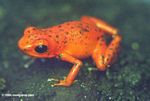 Rhett Butler (of Mongabay) has returned from his recent travels. This photo of a poison dart frog is from that trip. Go here to see a slide show of Panama (highly recommended). One of his first posts tells us:
Rhett Butler (of Mongabay) has returned from his recent travels. This photo of a poison dart frog is from that trip. Go here to see a slide show of Panama (highly recommended). One of his first posts tells us:
China has agreed to invest in a $5.5 billion biofuels project on the islands of New Guinea and Borneo … According to The Wall Street Journal, one million hectares [3,861 square miles, which would take 4 hours to drive around at 60 MPH] have been reserved for the eight-year plan, which would convert tropical forest for oil palm, sugar, and cassava plantations.
The article goes on to say that these governments have promised to spare 84,000 square miles of mountainous rainforest in the center of Borneo (to get the environmentalists off their back). Go to this WWF site for a graphic demonstration of how fast Borneo is being consumed.
While you are there, note that the article associated with the graphic makes no mention of biofuels. It is worried about palm oil being used for food. A biodiesel or ethanol powered car will eat an order of magnitude (or two) more oil or sugar than its driver will in a year. Palm oil and sugarcane are far, far more prolific producers than soy or even cellulose.
This is insanity. The destruction appears incremental on a human time scale but put it to time lapse graphics and understand that if each increment isn’t stopped, it never will be. This is what is behind the fight to spare the Arctic National Refuge. A line has been drawn.
We need a lot more lines. If demand continues to grow, and it will if consumers continue to support these fuels, there will be nothing left of the carbon sinks of Borneo, promises to the contrary be damned.
Go to Mongabay for several more interesting articles.
 Rhett Butler (of
Rhett Butler (of 
